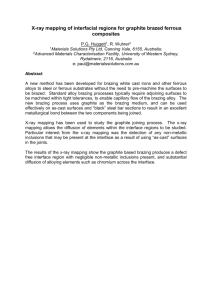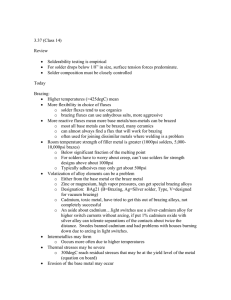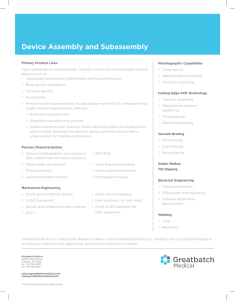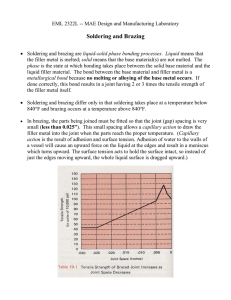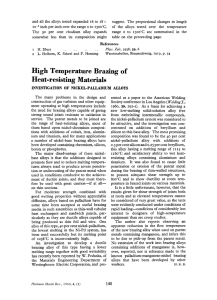nickel-chromium-based amorphous brazing foils for continuous
advertisement
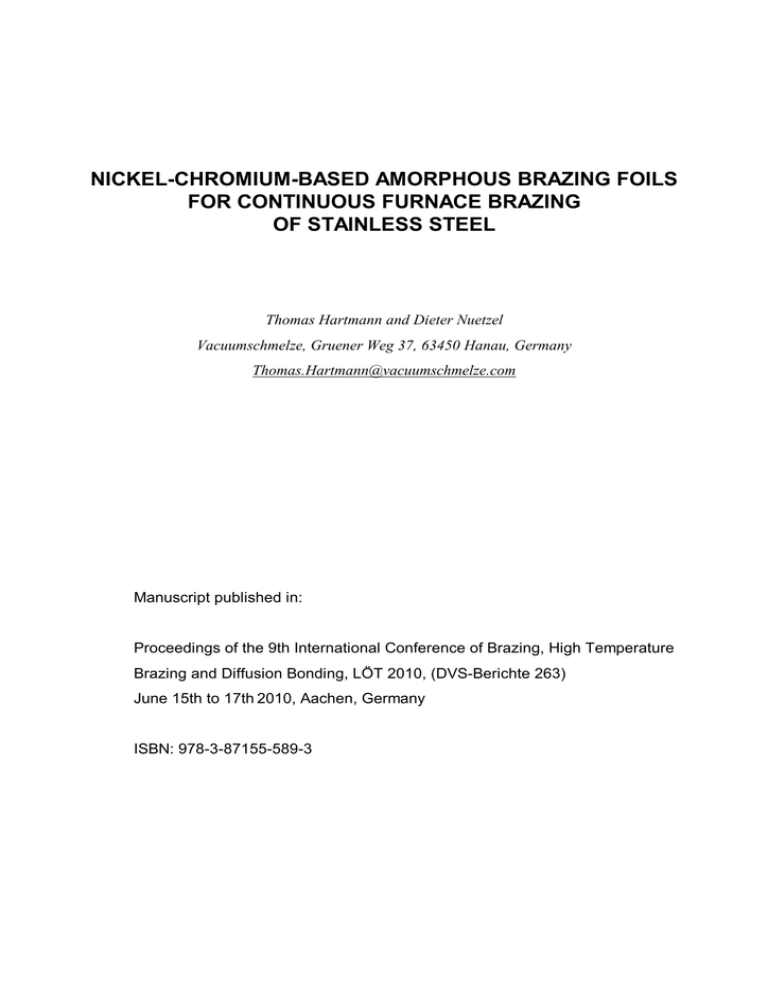
NICKEL-CHROMIUM-BASED AMORPHOUS BRAZING FOILS FOR CONTINUOUS FURNACE BRAZING OF STAINLESS STEEL Thomas Hartmann and Dieter Nuetzel Vacuumschmelze, Gruener Weg 37, 63450 Hanau, Germany Thomas.Hartmann@vacuumschmelze.com Manuscript published in: Proceedings of the 9th International Conference of Brazing, High Temperature Brazing and Diffusion Bonding, LÖT 2010, (DVS-Berichte 263) June 15th to 17th 2010, Aachen, Germany ISBN: 978-3-87155-589-3 NICKEL-CHROMIUM-BASED AMORPHOUS BRAZING FOILS FOR CONTINUOUS FURNACE BRAZING OF STAINLESS STEEL Thomas Hartmann, Dieter Nützel, Hanau / Germany Modern vehicles are equipped with special components both to reduce emissions and to improve fuel economy. These devices are mainly located in the exhaust section of the combustion engine. They are generally made out of stainless steel to withstand the high temperatures and corrosive environment. These parts are primarily brazed using corrosion resistant brazing alloys either in paste or foil form. To reduce production costs, the use of continuous brazing furnaces beside the well established vacuum furnaces is becoming more and more important. This paper presents an investigation of stainless steel joints brazed with different amorphous foils of Ni-Cr-Si-B-X and Ni-Cr-P-X suitable for continuous furnace brazing operation. The examination of flow behaviour, corrosion resistance and mechanical properties are discussed and compared. In conclusion, the recently developed VITROBRAZE 2170 brazing foil is shown to be an attractive solution for joining stainless steel components in a continuous furnace. 1. range well above the maximum temperature of continuous furnaces. To improve the performance and efficiency of modern plate type or flat tube coolers especially for EGR applications, the designs are becoming increasingly compact and complex. These configurations result in a large number of internal braze joints. By using continuous style CAB furnaces, the gas exchange of protective atmosphere and residual oxygen within these very convoluted, internal areas of the cooler is getting more and more critical. An inadequate brazing atmosphere results in defects in the brazing joints as well as insufficient strength and leak tightness of the brazed parts. This problem is getting even more critical when brazing pastes are used where the decomposition of the organics during heating up to brazing temperature will cause additional volatile residues. Thus, amorphous brazing foils which contain no organic binders are the preferred brazing filler material for these new generation plate-type or flat-tube EGR coolers. INTRODUCTION In order to reduce emissions of combustion engines and improve fuel economy, cars are equipped with different brazed devices such as diesel particulate filters, metallic substrate catalytic converters, exhaust gas recirculation coolers (EGR) and, more recently, heat recovery systems and similar devices using the waste heat of the exhaust gas. To meet the application requirements, these complex shaped stainless steel parts require high levels of mechanical strength, fatigue as well as corrosion and oxidation resistance. Brazing with Ni-Cr-based filler materials either in paste or foil form is a favorable option. By using amorphous Ni-Cr-based brazing foils, manufacturers can realize fully automated, highly efficient mass production lines with lowest reject rates, which makes the amorphous brazing foil technically as well as economically attractive. Overall, the production process using amorphous brazing foils shows distinct technological and commercial advantages in comparison to a brazing paste process. Joining of stainless steel components with Ni-Cr filler metals in vacuum furnaces has been a well established process in the industry for many decades. In the last years, the use of continuous conveyer-belt furnaces under controlled atmosphere (CAB furnace) is getting more and more common due to the lower capital and operating costs (Figure 1). Additionally, the continuous operation mode of such conveyer-belt furnaces can be easily integrated into highly efficient production lines. However, the change to this furnace type for brazing of corrosion resistant stainless steel parts affects the brazing filler material selection. Based on the temperature resistance of the conveyerbelt and the thermal insulation of the continuous furnace, the maximum service temperature is typically limited to around 1100°C. This temperature limitation requires filler materials with a brazing temperature in the range of 1050 - 1080°C. Therefore, most of the corrosion resistant standardized Ni-Cr brazing filler materials like e.g. BNi-5 can no longer be used. The high Chromium content of these well-known alloys leads to a melting Figure 1: Controlled atmosphere conveyer belt furnace (Tokyo Braze) 2. BRAZING FILLER MATERIAL SELECTION As mentioned previously, several aspects favour filler metals in the form of amorphous foils with a brazing range of 1050 - 1080°C combined with a high corrosion resistance. The alloy systems where it is possible to realize these properties are Ni-Cr-Si-B-X and Ni-Cr-P-X. However, the corrosion resistance and 42 honeycombs or tube assemblies. However, BNi-7 is not available as amorphous foil in an industrial scale. Due to this fact, Vacuumschmelze GmbH & Co KG developed its VITROBRAZE® 2170 (VZ2170). This new amorphous brazing foil (ABF) has a Ni-Cr-Si-B-P composition containing 21% Chromium [3]. mechanical strength of these filler materials as well as the influence of brazing parameters, like temperature and time, on the joint properties are quite different. To develop a better general understanding of the alloy systems, we carried out some basic tests with different amorphous VITROBRAZE® brazing foils and one Ni-Cr-Si-P paste. The selected brazing filler metals are listed in Table 1. In recent years, new Ni-Cr-P-X brazing alloys with high Chromium contents have been successfully used in several industrial applications. These compositions have beneficial low melting point and superior corrosion resistance [4,5,6,7]. However, these alloys are currently only available as powder or paste products and their compositions did not match to any commercialized amorphous brazing foil. Therefore, a brazing filler material (BFM) out of this group in form of powder was included in our investigation. The selected brazing alloy with the designation FP-613, by courtesy of Tokyo Braze Co. Ltd (Tokyo, Japan), has the composition Ni-29Cr-4Si-6P. The Ni-Cr-Si-B group was the first Chromium containing brazing alloy system entering into industrial applications [1]. Out of this group, BNi-2 filler metal is the ideal choice for protective atmosphere furnace brazing for a wide variety of brazed parts. This brazing alloy became the most widely employed Nickel filler metal because of three factors: (i) compatibility with almost every base material, (ii) availability in powder, paste, tape and amorphous foil form, (iii) low cost [2]. The brazing temperature of Ni-Cr-B-Si filler metals is strongly Table 1: Chemical compositions and melting ranges of selected brazing filler materials Alloy System Ni-Cr-Si-B-X Ni-Cr-P-X Melting Range [°C] Composition [wt.%] Alloy Form* Ni Fe Cr Mo P Si B Tl Ts VZ 2120 (BNi-2 / NI 102) 82.4 3 7 - - 4.5 3.1 1025 970 F Alloy #1 80.5 - 9 1.5 - 7 2 1050 980 F VZ 2170 70 - 21 - 8 0.5 0.5 925 880 F BNi-7 / NI 107 76 - 14 - 10 - - 890 890 F FP-613 61 - 29 - 6 4 - 1030 965 P *): F = amorphous foil, P = Powder/Paste product associated with the Chromium and Boron content. To improve the corrosion resistance of the Ni-Cr-Si-B-X type alloys, it is necessary to increase the Chromium and to reduce the Boron content. However, if the Chromium content reaches levels above 10%, the brazing temperature exceeds 1100°C. Considering the limited brazing temperature of belt type furnaces, the melting temperature of improved alloy compositions should not exceed 1050 - 1060°C. This limitation leads to a modified composition Ni-9Cr1,5Mo-7Si-2B wt% with a liquidus temperature of 1050°C as an option for an improved ABF composition. 3. EXPERIMENTAL PROCEDURE 3.1 Brazing procedure Basic brazing tests were conducted to analyze the influence of brazing temperatures and time at temperature on the joint properties. These tests were made in a vacuum furnace (vacuum level < 1x10-3 mbar). Meanwhile, the results of the enclosed investigation relating the commercially available VZ 2120 and VZ 2170 brazing foils have been confirmed in several industrial applications using a continuous CAB furnace for brazing exhaust gas components. BNi-7 out of the Ni-Cr-P-system does not require an ultra dry hydrogen or vacuum atmosphere. Satisfactory brazing has even been realized in low cost atmospheres like dry dissociated ammonia or nitrogen-base atmospheres. This filler metal can be used for joining Iron- or Nickel-base alloys when adequate diffusion cycles are used. Furthermore, BNi-7 is a brazing alloy with a very high fluidity and a good high-temperature corrosion resistance. Typical applications of this brazing alloy are radiators, 3.2 Wetting and flowing behaviour To evaluate the wetting behavior of the filler metals on a 316L stainless steel substrate, a spreading test was conducted. ABF samples were wound to a core (outer diameter 8 mm / height 25 mm) of 1 g. The core itself was fixed by tack welding and placed to the center of a stainless steel substrate (size 30 mm x 30 mm). The samples were heated up in a vacuum 43 hours. After exposure, the weight loss of the brazed samples was measured and a metallographic analysis was made. The samples are 316L coupons with a diameter of 25 mm and a height of 6 mm. Two 316L tubes (length 25 mm, outer diameter 4 mm, wall thickness 0,5 mm) were brazed side by side onto the centre of the coupon by using a brazing foil disc (diameter 25 mm, foil thickness 0,05 mm) as interlayer (Figure 3). The total weight of the sample is 25,5 g, hence, the percentage of the brazing material is 0,7 %. By using this testing procedure, the corrosion resistance will be affected not only by the composition of the base material and the BFM´s but also by the quantity of the BFM, the size of the area wetted by the BFM as well as the brazing parameters, which is important for practical relevance. furnace to 1090°C. The spreading ratio of the molten filler metal was defined as: SR=Af/As where Af is the area covered by the molten filler metal and As is the substrate area. To determine the flow behavior of the filler metals in a capillary gap, 316L stainless steel T-specimens (length 115 mm, sheet thickness 3 mm) with a gap clearance of 0,1 mm were prepared. The samples were placed horizontally in the furnace and 1g ABF was placed at one end of each sample. After heating to 1090°C and holding for 15 minutes the flow within the brazing gap was measured. The flowing ratio of the filler metal was defined as: FR=Lf/Lg 316L tubes where Lf is the distance filled by the molten filler metal and Lg is the total gap length of the sample. Brazing foil 316L coupon 3.3 Mechanical strength The ultimate tensile strength of the brazing joints was analyzed using a static tensile test. The sample geometry was a butt brazed tensile specimen according to DIN EN 12797:2000 (Figure 2). Base metal was stainless steel 316L. Before brazing the joint area of the base metal was ground and cleaned with acetone. Up to three layers of brazing filler metal foil (thickness 50 µm) was placed between the base metal cylinders also acting as joint spacer. The cylinders were then fixed together by spot Figure 3: Brazed sample for corrosion test RESULTS AND DISCUSSION 4.1 Ni-Cr-Si-B-(X) System VZ 2120 shows a sufficient wetting and an excellent flowing behavior on the 316L substrate at 1090°C (Figure 4). The wetting of Alloy #1 with higher Chromium content than VZ 2120 is depressed mainly due to the higher melting temperature of this alloy, but still an excellent flow was observed. The tensile strength of brazed Ni-Cr-Si-B-X joints always exhibit values in the range of the yield strength of the base metal (~230 MPa). If brazing gaps are kept below 0,1 mm, the tensile strength of the joint will increase significantly (Figure 5a). This is caused from the well known phenomena of a depressed formation of brittle phases e.g. CrxBy and NiSix compounds in the center region of the joint if the gap clearance is below certain limits [9,10]. Especially plate type structures brazed with amorphous foils offer the possibility to keep the brazing gaps below 0,1 mm and to exploit the higher mechanical strength and the better ductility of the Ni-Cr-Si-B brazed joints. The tensile strength of Alloy #1 does not reach the level of VZ 2120. This could be caused from the Figure 2 : Butt brazed tensile test specimen according to DIN EN 12797, Typ 3 welding to adjust the defined brazing clearance. 3.4 4. Corrosion resistance Within this investigation, samples of the base material 316L brazed with different brazing foils were analyzed in a quantitative corrosion test. As corrosion media, a synthetic exhaust condensate with a pHvalue of 1,6 and sulphate-, nitrate- and chloride ions like in previous works was used [3,8]. The samples were exposed at a temperature of 70°C for 1000 44 addition, the increased brazing temperature generates higher degrees of base metal erosion which leads to a higher content of diluted Fe in the joint. This could also explain the variation of the joint properties as described above. higher Silicon content of Alloy #1. Currently there are no detailed results for the solubility of Silicon in a NiCr-Matrix published, but due to our experience with different compositions, the solubility of Silicon depends on the exact matrix composition as well as on the brazing parameters. If the Silicon amount is higher than the solubility limit of the Ni-Cr matrix, the Silicon generate more brittle NiSix compounds which could negatively influence the mechanical joint behavior. Figure 6 shows the effect of brazing temperature on mass-loss after the 1000 h corrosion test. As seen in this figure, the weight losses of both Ni-Cr-Si-B-X alloys were high. Metallographical inspection of the samples confirms the mass-loss result. The areas where the corrosive attack primarily occurs are the NiSix compounds that are free of Chromium. In addition, the interfacial base metal area where excessive CrxBy formation causes a Chromium depletion on the base metal grain boundaries is affected by corrosion. Spreading ratio (SR) Tensile Strength [MPa] 400 VZ 2120 FP-613 Alloy #1 VZ 2170 BNi-7 300 200 100 0 0,03 0,05 0,08 0,10 0,13 Joint clearance [mm] 0,15 0,18 (a) Effect of joint clearance on tensile strength; brazing temperature 1090°C; brazing time 30 minutes Flowing ratio (FR) VZ2120 400 Tensile Strength [MPa] FP-613 VZ 2170 BNi-7 Alloy #1 VZ 2120 BNi-7 FP-613 300 VZ2170 200 100 0 1000 0% 20% 40% 60% 80% 100% 1050 1100 1150 1200 Brazing temperature [°C] (b) Effect of brazing temperature on tensile strength; joint clearance 0,05 mm; brazing time 30 minutes. Figure 4: Wetting and flowing behavior of various filler metals on a 316L stainless steel substrate at 1090°C 4.2 Tensile Strength [MPa] 400 Ni-Cr-P-(X) System Due to the high Phosphorus content, all selected alloys of this group have a high fluidity. They show excellent wetting and flowing behavior on a 316L substrate at 1090°C and can bridge a capillary gap of at least 100 mm (Figure 4). For BNi-7 the value of the tensile strength of the brazed specimens depends on the brazing temperature (Figure 5b). If this alloy is brazed at 1030°C, the tensile strength reaches only 60% of the base metal yield strength. To increase the tensile strength of the joints, it is necessary to braze at higher temperatures or to increase time at brazing temperature (Figure 5c). Samples joined at 1150°C for 30 minutes reached strength values in the range of the base metal yield strength (Figure 5b). However, inverse to the improvement of the mechanical strength, the corrosion resistance of BNi-7 degrades dramatically by higher brazing temperature (Figure 6). These specific characteristics of BNi-7 joints are probably caused by the diffusion of the constituent elements. In 300 200 100 VZ 2120 FP-613 VZ 2170 BNi-7 0 0 15 30 45 Time on brazing temperature [min] 60 (c) Effect of brazing time on tensile strength; joint clearance 0,05 mm; brazing temperature 1090°C Figure 5: Joint strength of butt brazed 316L specimens brazed with various filler metals at different brazing parameters While retaining superior wetting and flowing behavior, the joint properties of VZ 2170 are much better in terms of strength and corrosion resistance compared to BNi-7. At brazing temperatures of 1030°C, this alloy exhibits a tensile strength 40% higher compared to BNi-7 brazed under the same conditions. 45 operations carried out in continuous CAB-furnaces. Within the process window described above, the NiCr-Si-B-X system possesses beneficial mechanical properties if joint clearance is kept below 0,1 mm. If the joint clearance is wider than 0,1 mm, all tested alloys, except BNi-7, exhibit sufficient joint strengths close to the base metal yield strength. The joint strength of the pure Ni-Cr-P system like BNi-7 is significantly reduced compared to the other alloys. A brazing cycle which leads to a higher degree of diffusion (high temperature, long time at brazing temperature) enhances the mechanical properties of BNi-7, but reduces the economical efficiency of the process. We have found for the Ni-Cr-P-X system that substitution of Phosphorous for other elements, e.g. Silicon or Boron, improves the mechanical behavior of the joints with an economical “lowtemperature-short-time” brazing cycle. Modified NiCr-P-X alloys like FP-613 or VZ 2170 exhibit superior joint strength compared to BNi-7 at short-time brazing cycles and brazing temperatures below 1100°C. The corrosion resistance of joints made out of the selected alloys is strongly affected by the brazing temperature. Best results were obtained for specimens brazed at the lower end of the brazing Mechanical strength of VZ 2170 is stable in the temperature range from 1030°C to 1150°C and did not show any influence of the joint clearance (Figure 5a). However, samples brazed at temperatures of 1000°C and below showed an insufficient mechanical behavior. Therefore brazing temperatures below 1030°C should be avoided. The corrosion resistance of VZ 2170 reaches better values than Ni-Cr-Si-B-X alloys or BNi-7, especially if brazed at 1030°C, in which case, best levels could be reached. Metallographic inspection of VZ 2170 after the corrosion test does not show any significant corrosive attack either at the braze joint or at the base metal interface (Figure 6). It is important to note, that although VZ 2170 has a Boron content of 0,5 wt.%, no excessive Boron segregation at the interfacial area to the base metal could be observed. FP-613 out of the Ni-Cr-Si-P alloy system has some metallurgical advantages which gives the brazed joints a superior corrosion resistance and constant mechanical properties, irrespective of the brazing conditions. The wetting and flowing test shows highest values like all Phosphorous containing alloys. Due to the higher melting point of FP-613 we could not perform tests at 1030°C. VZ 2170 Alloy #1 VZ 2120 BNi-7 FP-613 0,2 Mass-loss [%] 0,15 0,1 0,05 0 1000 1050 1100 1150 1200 Brazing temperature [°C] Figure 6: Effect of brazing temperature on mass-loss of various filler metals after 1000 h immersion time in corrosive media and metallographic analysis after corrosion test. Base metal 316L / Brazing time 15 minutes 4.3 range. Thus, the brazing parameters should be very carefully selected and controlled for every brazing alloy. Due to the low chromium content Ni-Cr-Si-B-X alloys exhibit a very limited corrosion resistance. By using a “low-temperature-short-time” brazing cycle we could observe an extensive formation of NiSix and CrxBy in the centerline of the brazed joint and of CrxBy at the interface to the base metal. These intermetallic compounds degrade the mechanical and corrosive behavior of the brazed stainless steel joints. To Comparison of the results For brazing alloys to be used in conveyer belt furnaces, it is essential to ensure a good workability and to reach satisfactory joint properties at short brazing cycles (10-30 minutes) with brazing temperatures around 1050°C. The ability to bridge at least 100 mm brazing gap length, indicates that all selected brazing foils are good candidates for brazing 46 achieve a better corrosion resistance, it is essential to add more than 10% Chromium to a Ni-Cr-Si-B brazing alloy and to use brazing temperatures of more than 1100°C with appropriate holding times to achieve good diffusion of the elements. In particular, with the favored “low-temperature-short-time” process parameters Ni-Cr-P-X alloys offer beneficial corrosive behavior over the selected Ni-Cr-Si-B-X alloys, especially for exhaust gas devices. 5. [5] S. Nagai, K. Tanaka, K. Hidaka (2000) Characteristics of a Newly Developed Nickel Brazing Filler Metal; Proceedings of the 2000 Powder Metallurgy World Congress, Kyoto, Japan [6] K. Matsu, Y. Miyazawa, T. Ariga (2009) Development of Novel th Fe-Cr Based Brazing Filler Metals; Proceedings of the 4 International Brazing and Soldering Conference, IBSC 2009, Orlando, USA, p. 110-118 [7] S. Rangaswamy, D. Fortuna (2007) Novel high chromium containing braze filler metals for heat exchanger applications; th Proceedings of the 8 international Conference on Brazing, High Temperature Brazing and Diffusion Bonding, LÖT 2007, Aachen; DVS Berichte 243, p. 12-17 [8] T. Hartmann, D. Nützel (2007) Iron containing brazing foils for th joining of stainless steels; Proceedings of the 8 international Conference on Brazing, High Temperature Brazing and Diffusion Bonding, LÖT 2007, Aachen; DVS Berichte 243, p. 140-145 [9] K. D. Partz (1981) Einfluss von Lötparametern auf die Festigkeit stumpfgelöteter Hochtemperaturlötverbindungen – Parametercharakteristik der Lötsysteme BNi-2, BNi-5, BNi-7 / 1.4961, 1.4550; Technisch- wissenschaftliche Berichte der RWTH Aachen, Nr. 4.13.7.81-1981 SUMMARY With respect to the usability in conveyor belt CABfurnaces, several brazing alloys with melting temperatures below 1060°C were selected from the Ni-Cr-Si-B-X and Ni-Cr-P-X system for this study. The interaction between the brazing parameters temperature, time and gap clearance on tensile strength and corrosive behavior has been investigated. The following results have been obtained in this study: (1) The wetting and flowing behavior of all tested Ni-Cr-P-X alloys shows better results than NiCr-Si-B-X alloys. (2) The ultimate tensile strength of joints brazed with VZ 2170 reaches better values compared to BNi-7 brazed joints. (3) In contrast to Ni-Cr-Si-B-X alloys, the ultimate tensile strength of Ni-Cr-P-X alloys is not affected by the brazing clearance. (4) The highest level of joint strength was obtained for joints brazed with Ni-Cr-Si-B-X alloys and brazing gaps in the range of 0,05 mm. (5) The corrosion resistance of joints brazed with Ni-Cr-P-X alloys is superior to that of joints brazed with Ni-Cr-Si-B-X alloys, mainly because of the higher Chromium content. (6) The corrosion resistance of joints brazed with VZ 2170 reaches highest level if brazed at the lower end of the brazing temperature range. [10] D. Nützel, T. Hartmann (2007) NiFe brazing foils with melting th temperatures < 1000°C; Proceedings of the 8 international Conference on Brazing, High Temperature Brazing and Diffusion Bonding, LÖT 2007, Aachen; DVS Berichte 243, p. 23-27 References [1] R. L. Peaslee (2003) Brazing Footprints; Wall Colmonoy Corporation; ISBN: 0-9724479-0-3, S. 196-198 [2] American Welding Society (1991) The Brazing Handbook; IBSN: 0-87171-359-4 [3] T. Hartmann, D. Nützel (2009) New amorphous brazing foils for th exhaust gas applications; Proceedings of the 4 International Brazing and Soldering Conference, IBSC 2009, Orlando, USA, p. 110-118 [4] Y. Miyazawa, K. Denda, Y. Miyamoto, T. Ariga (2003) Brazing of Stainless Steel By Using Ni-Cr-Si-P Brazing Filler Metal; nd Proceedings of the 2 International Brazing and Soldering Conference, IBSC 2003, San Diego, USA 47
